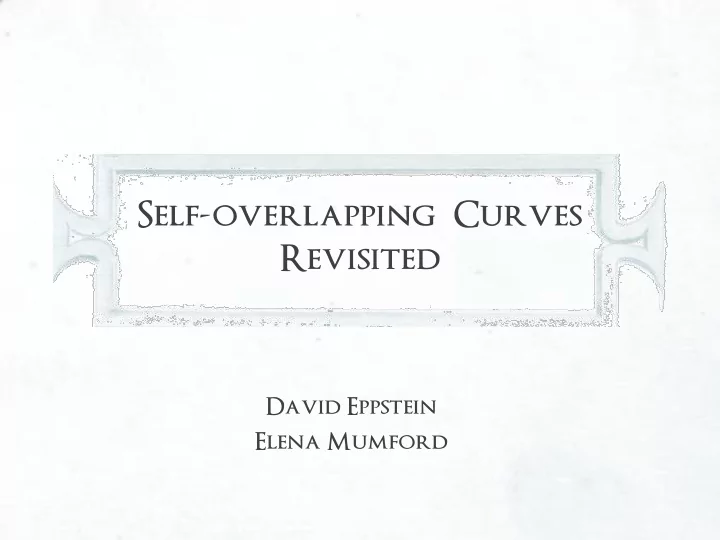

Self-overlapping Curves Revisited David Eppstein Elena Mumford
Curves as Surface Boundaries
Immersion An immersion of a disk D in the plane is a continuous mapping i: D → R 2 disk immersed disk in the plane in the plane i i n(p) : n(p) → i(n(p)) is a homeomorphism .
Immersion An immersion of a disk D in the plane is a continuous mapping i: D → R 2 disk immersed disk in the plane in the plane n(p) i i(n(p)) i n(p) n(p) i(n(p)) i n(p) : n(p) → i(n(p)) is a homeomorphism .
Immersion The image of the boundary of the disk is a (self-intersecting) closed curve. disk immersed disk in the plane in the plane i disk boundary self-intersecting curve in the plane in the plane i
Embedding An embedding of a disk e: D → R 3 e: D → e(D) is a homeomorphism. disk disk embedded in space in the plane as a generalized terrain e We consider a special type of embeddings: one side of e(D) consistently points up.
Embedding An embedding of a disk e: D → R 3 e: D → e(D) is a homeomorphism. disk disk embedded in space in the plane that is NOT a generalized terrain e We consider a special type of embeddings: one side of e(D) consistently points up.
Embedding An embedding of a disk e: D → R 3 e: D → e(D) is a homeomorphism. disk disk embedded in space in the plane that is NOT a generalized terrain e We consider a special type of embeddings: one side of e(D) consistently points up.
Examples By Flickr user Mark Wheeler from http://www.flickr.com/photos/markwheeler/246569058/
Examples By Flickr user Mark McLaughlin from http://www.flickr.com/photos/clocky/257469851/
Embedding disk embedded in space immersed disk as a generalized terrain in the plane pr z the boundary of a disk self-intersecting curve embedded in space in the plane pr z
Problem Statement disk embedded in space as a generalized terrain disk immersed in the plane (self-intersecting) curve in the plane
Problem Statement disk embedded in space as a generalized terrain ? ? disk immersed in the plane ? (self-intersecting) curve in the plane
Problem Statement disk embedded in space as a generalized terrain ? ? disk immersed ? in the plane ? (self-intersecting) curve in the plane
Bennequin Disk i An immersed disk that is not a projection of a disk embedded in space
Bennequin Disk i An immersed disk that is not a projection of a disk embedded in space
Bennequin Disk i An immersed disk that is not a projection of a disk embedded in space
Bennequin Disk i An immersed disk that is not a projection of a disk embedded in space
Problem Statement disk embedded in space as a generalized terrain ? ? disk immersed ? in the plane Whitney(1937) Shor and van Wyk(1992) (self-intersecting) curve in the plane
Problem Statement disk embedded in space as a generalized terrain NP-complete ? disk immersed ? in the plane Whitney(1937) Shor and van Wyk(1992) (self-intersecting) curve in the plane
Bennequin Disk II
Bennequin Disk II
Problem Statement disk embedded in space as a generalized terrain NP-complete ? disk immersed ? in the plane open Whitney(1937) Shor and van Wyk(1992) (self-intersecting) curve in the plane
Generalize the Problem disk with a surface (two-dimensional manifold) boundary with a boundary closed curve multiple closed curves
Disk → Manifold
Multiple Curves
Generalize the Problem surface embedded in space as a generalized terrain ? ? surface immersed in the plane ? multiple (self-intersecting) curve in the plane
Results [Shor and van Dyk]
Lift a Disk Theorem Lifting an immersed disk is NP-complete. Proof : By reduction from ACYCLIC PARTITION. u v w u v w
Acyclic Partition Given: a digraph G = (V, E) Find: partition of V into sets V 1 and V 2 : G(V 1 ) and G(V 2 ) in G are acyclic. u v w u v w Theorem ACYCLIC PARTITION is NP-complete. Proof : By reduction from PLANAR 3-SAT.
Lift a Disk Theorem Lifting an immersed disk is NP-complete. Proof : By reduction from ACYCLIC PARTITION. u v w u v w
Lift a Disk u v w u v w v w vertices: u (w, u) (v, u) (v, w) (u, v) edges: w v u
Lift a Disk u w on the same side of the purple disk
Lift a Disk u w on different sides of the purple disk
Lift a Disk u v
Lift a Disk u v w u v w
Summary [Shor and van Dyk]
Cased Curves A cased curve can be decided in O(min(nk,n+k 3 )).
Summary [Shor and van Dyk]
The End
Recommend
More recommend